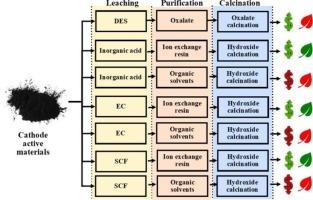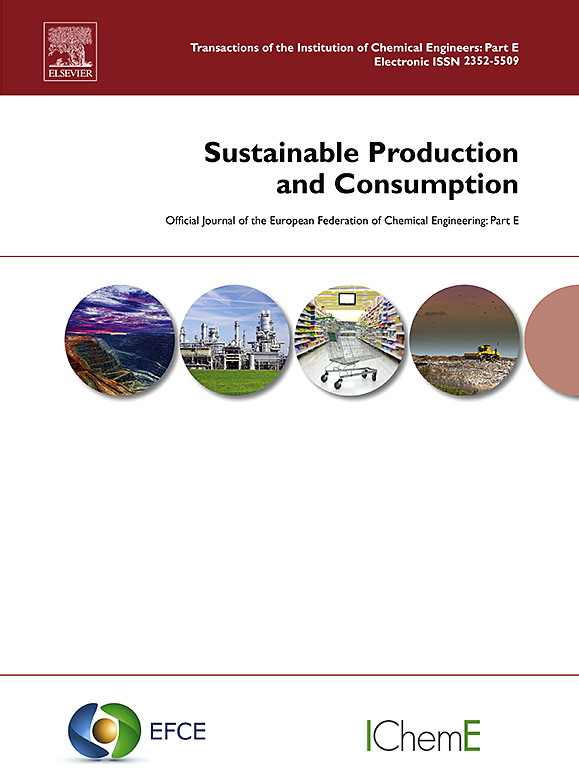Comparative environmental and economic assessment of emerging hydrometallurgical recycling technologies for Li-ion battery cathodes
IF 10.9
1区 环境科学与生态学
Q1 ENVIRONMENTAL STUDIES
引用次数: 0
Abstract
The growing demand for electric vehicles has led to a growing concern for battery recycling, particularly for critical raw materials. However, there is insufficient investigation into the environmental and economic impacts of hydrometallurgical recycling methods. In this study we explored emerging hydrometallurgical technologies in economic and environmental perspective to establish conceptual routes to recover Co, Ni and Mn oxides from waste LiNi0.33Mn0.33Co0.33O2 cathode materials from spent Li-ion batteries. After, life cycle assessment and costing techniques were utilized to compare the environmental and economical performances of each conceptual route. Recovery efficiency of metal oxides through each route was also considered as a key factor. Results suggested that deep eutectic solvent-based leaching produces the highest impact under many impact categories while electrolysis-based leaching showed the least. Under purification technologies assessed, ion-exchange based purification showed significantly lower impact under many categories except stratospheric ozone depletion. Solvent based purification has been identified as the worst technology for purification. Hydroxide based calcination has been identified as the most environmentally sustainable calcination method compared to oxalate calcination. The route consists with inorganic leaching, ion-exchange based purification and hydroxide calcination showed the lowest environmental impact (emission effect at 33.8 kg CO2 eq), with lower economic impact ($ 119) and the highest recovery efficiency (78 %) per 1 kg of cathode active materials. However, using electrolysis-based leaching can slightly increase the impacts with lower recovery efficiency (75 %) and better economic performance ($104/kg of cathode active materials). Terrestrial ecotoxicity was identified to be the most affected impact category for the recovery processes. It is recommended that technologies like deep eutectic solvent-based leaching, solvent extraction and environmentally sustainable technologies like supercritical fluid extraction need further studies prior to industrial applications.

锂离子电池阴极新兴湿法冶金回收技术的环境和经济比较评估
随着电动汽车需求的不断增长,人们越来越关注电池的回收利用,尤其是关键原材料的回收利用。然而,对湿法冶金回收方法的环境和经济影响的调查还不够充分。在本研究中,我们从经济和环境的角度探讨了新兴的湿法冶金技术,以建立从废旧锂离子电池的 LiNi0.33Mn0.33Co0.33O2 正极材料中回收 Co、Ni 和 Mn 氧化物的概念路线。之后,利用生命周期评估和成本计算技术比较了每种概念路线的环境和经济性能。通过每种途径回收金属氧化物的效率也被视为一个关键因素。结果表明,在许多影响类别中,基于深共晶溶剂的浸出法产生的影响最大,而基于电解的浸出法产生的影响最小。在所评估的净化技术中,除平流层臭氧消耗外,基于离子交换的净化技术在许多类别中的影响明显较低。溶剂净化被认为是最差的净化技术。与草酸盐煅烧法相比,氢氧化物煅烧法被认为是最具环境可持续性的煅烧法。由无机沥滤、离子交换提纯和氢氧化物煅烧组成的路线对环境的影响最小(排放效应为 33.8 千克二氧化碳当量),对经济的影响较小(119 美元),每 1 千克阴极活性材料的回收效率最高(78%)。然而,使用电解法浸出会略微增加对环境的影响,但回收效率较低(75%),经济效益较好(每公斤阴极活性材料 104 美元)。陆地生态毒性被认为是对回收工艺影响最大的类别。建议在工业应用之前,需要进一步研究深共晶溶剂浸出、溶剂萃取等技术以及超临界流体萃取等环境可持续技术。
本文章由计算机程序翻译,如有差异,请以英文原文为准。
求助全文
约1分钟内获得全文
求助全文
来源期刊

Sustainable Production and Consumption
Environmental Science-Environmental Engineering
CiteScore
17.40
自引率
7.40%
发文量
389
审稿时长
13 days
期刊介绍:
Sustainable production and consumption refers to the production and utilization of goods and services in a way that benefits society, is economically viable, and has minimal environmental impact throughout its entire lifespan. Our journal is dedicated to publishing top-notch interdisciplinary research and practical studies in this emerging field. We take a distinctive approach by examining the interplay between technology, consumption patterns, and policy to identify sustainable solutions for both production and consumption systems.
 求助内容:
求助内容: 应助结果提醒方式:
应助结果提醒方式:


